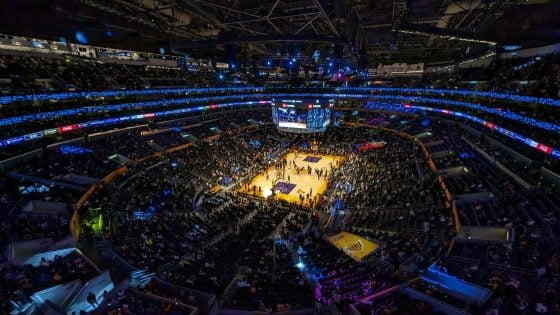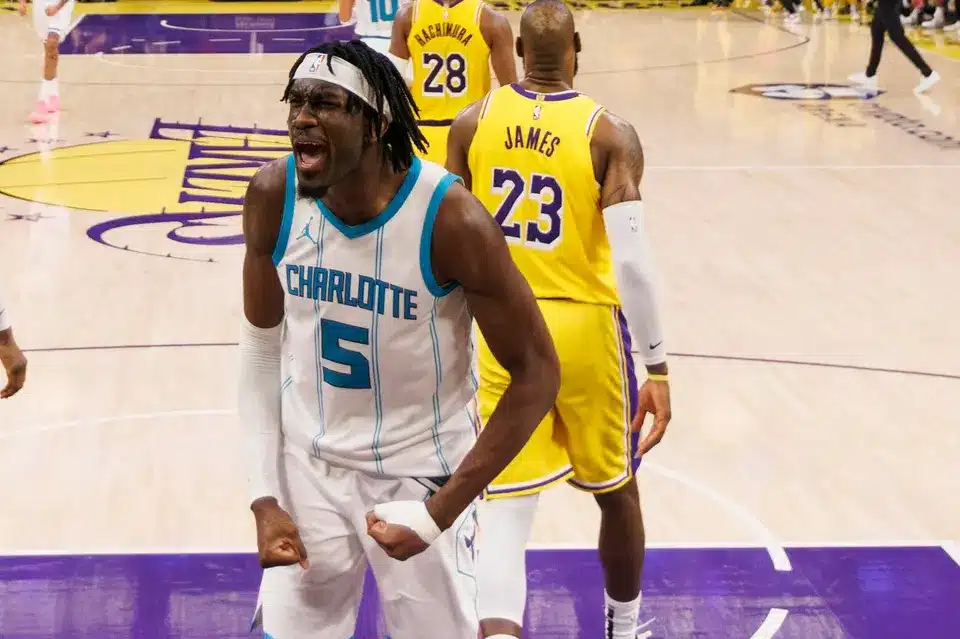#1 – Is Jayson Tatum a point guard?
Over the last two games, Jayson Tatum has delivered 19 assists and is averaging seven assists per game in February. As the season progresses, his approach to the game seems to have shifted to a more ball-dominant role. He’s becoming more heliocentric, and his pick-and-roll volume has increased significantly.
With Karl-Anthony Towns’ inability to play drop coverage and his lack of lateral movement, the Celtics exposed the Knicks’ defensive weaknesses once again. Alongside Porziņģis or Kornet ball screens, Jayson Tatum can manipulate the defense. If the Knicks drop, he takes the pull-up or dishes it to Porziņģis on the pick-and-pop.
If they switch, Tatum can either attack the mismatch or feed his teammates. Whatever the defense tries to do, stopping him feels impossible. Even when defenses send two players at him, his length, passing, and ball handling help him maneuver around it and find great solutions.
#2 – Porziņģis looks really healthy
One of the reasons Tatum has been so effective in the pick-and-roll is Porziņģis’ improved health. When he returned from injury—earlier than expected—he seemed a bit rusty. That wasn’t the case last night.
On both ends of the floor, Porziņģis was moving well, which provided significant value. Since the basketball court is cubic and not flat, having a player his size who can move so well is a game-changer. Thanks to this combination, he can consistently be present in the paint to disrupt opposing offenses.
Often, he roams the paint, leaving a non-shooter open—playing like a goalkeeper. And when he’s in good shape, like last night, he can also move well when switching or running in transition. Porziņģis’ rim protection and shooting are so valuable that he still provides impact even when out of shape—but when his body responds well, he becomes the ultimate difference-maker for the Celtics.
#3 – Knicks can’t protect the rim
Speaking of rim protection, the Knicks don’t have any. Recently, Celtics opponents have been leaving their center in the paint, ignoring Jrue Holiday beyond the three-point line. The Knicks, however, can’t do that.
They simply don’t have a rim protector. As a result, it was Brunson who was defending Holiday. Since Jrue Holiday is a great screener and can exploit mismatches in the post, his presence on the floor is a tremendous asset.
#4 – Jrue Holiday reminds us why he is key
Lately, Holiday has struggled to impact the game the way he did last year. His shooting isn’t as effective, and as mentioned earlier, teams are beginning to consider him a non-shooting threat. Because of that, the Celtics’ spacing hasn’t been as elite with him on the floor. As a result, Payton Pritchard has sometimes taken his place, which presents defensive challenges since opposing teams frequently target him.
Yet, yesterday afternoon, Jrue Holiday reminded us why he is so important—especially on defense. Because his shooting wasn’t an issue for spacing, he played 32 minutes and showcased his defensive versatility. He switched onto everyone, from Jalen Brunson to Karl-Anthony Towns.
His active hands, great positioning, and strong frame were key in disrupting the Knicks’ offense. If the Celtics face the Knicks in a playoff series, Holiday’s defensive impact will be crucial, and New York will need to find a way around him to have a chance at winning.
#5 – Josh Hart exposed Boston’s transition problem
One thing the Knicks did well last night was expose the Celtics’ transition defense—or lack thereof. Josh Hart is one of the most impressive transition players in the league, and he put that on full display.
Repeatedly, Hart pushed the pace in transition, and the Celtics couldn’t keep up. Thankfully, Boston limited turnovers and dominated the offensive glass, reducing transition opportunities. Nonetheless, on the few defensive rebounds the Knicks secured, it felt like the Celtics had no way of stopping them once they got out and ran.
#6 – Derrick White’s casual 19/9/7
There hasn’t been much All-Star buzz around Derrick White this season, but the former Spur remains one of the best—if not the best—non-All-Star players in the league. He fits seamlessly alongside Jayson Tatum thanks to his shooting, passing, and screening.
He can either be the ball-handler or the screener in pick-and-roll actions, and his shooting makes it impossible for defenses to double Tatum without giving White an open shot. He also utilizes his passing on short rolls, punishing teams that over-help.
Like Tatum, he can also feed his teammates when defenses switch. Offensively, it’s hard to find a flaw in his game, and that versatility brings so much flexibility to the Celtics.
#7 – Jaylen Brown on the move
Jaylen Brown has one of the lowest percentages of assisted field goals among NBA players this season—just 47%. The Finals MVP generates his own offense and doesn’t rely on teammates as much as others to get buckets. Yet, his scoring has been down this season, and his overall efficiency is below league average.
Against the Knicks, Brown adjusted his offensive approach with more off-ball movement and a higher pace in transition—an approach that could help boost his efficiency. Last night, 60% of his made field goals were assisted, signaling an increase in his off-ball activity.
This cut alongside Porziņģis is a great example of how Brown can benefit from better spacing if he increases his off-ball movement. Will Joe Mazzulla and Brown continue in this direction and turn things around for the All-Star offensively? Looking forward to finding out.
#8 – Pritchard’s synergy with the starters
Pritchard had an off night—both individually and collectively. It happens, but it’s important to understand why. His synergy with the starters when Tatum was on the bench felt off. Because Tatum was sitting, Pritchard had to take on more on-ball creation, which isn’t his ideal role in the Celtics’ system.
The beauty of Pritchard’s game is his off-ball threat and ability to create chaos when catching the ball on the move. But when he has to initiate offense from scratch, it’s not as effective. This highlights not only Tatum’s importance but also the need for the other four starters to step up in creation when he’s off the floor.
Regardless of Tatum’s presence, Pritchard should be benefiting from someone else’s on-ball creation—not the other way around.
#9 – Dominican battle
It was fun to see two of the best Dominican players, Al Horford and Karl-Anthony Towns, go at it—the old and new generation.
Both are modern bigs who have helped shape basketball’s evolution toward better spacing. Hopefully, they’ll inspire the next wave of Dominican talent—because the basketball world could use more players like Horford and Towns.
#10 – Back screen on baseline action
A new wrinkle appeared in the Celtics’ baseline actions on Sunday. Recently, they had been using stagger screens from sideline or baseline sets—but not last night. Instead, they went to a classic back screen to exploit the Knicks’ lack of rim protection.
Since the Knicks don’t have a true rim protector, they matched Karl-Anthony Towns with Porziņģis. By setting a back screen on Towns, the Celtics allowed Porziņģis to slip free and find an easy path to the rim.
It may seem like a small detail, but in a close game, these two buckets could have been game-changing.






